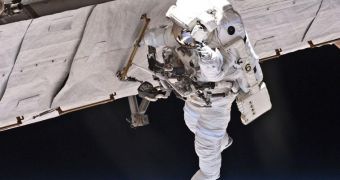Astronauts aboard the International Space Station (ISS) got up early this morning, in order to prepare for the last spacewalks of Atlantis' current mission to the orbital outpost. Two shuttle crew members will go outside the facility today, in a bid to replace additional solar batteries, and also transfer a grapple fixture from the orbiter's payload bay to the station. According to officials at NASA, if things run smooth, the astronauts may also tackle other issues, such as installing at least one ammonia jumper on the outer hull, and also resupplying toolboxes affixed to the exterior of the space lab.
The 12-astronaut crew that currently occupies the station awoke at 0550 GMT, as the extra-vehicular activity (EVA) is scheduled to begin at 1045 GMT. As most other spacewalks, it is scheduled to last for about 6 and a half hours, although that time frame may be extended if the situation demands it. For example, the first EVA of the mission took nearly seven and a half hours, due to delays and snags that made spacewalkers' work difficult. The new sortie will be conducted by STS-132 mission specialists Michael Good and Garrett Reisman, Space reports. They will exit to space via the Quest airlock.
During the second spacewalk, on Wednesday, Goof and astronaut Stephen Bowen, also an STS-132 mission specialist, installed four of six batteries, although only three were planned for the day. This leaves only two for today, which means that the spacewalkers may indeed have some extra time on their hands, to perform additional chores. “Originally we thought we'd have to perform three battery changes but because of the excellent work the crew did yesterday in our second spacewalk […] that allows us an opportunity to get ahead,” said yesterday Mike Sarafin, the NASA lead shuttle flight director. Each individual battery weighs in excess of 170 kilograms (375 pounds).
“On EVA 3 it's kind of a clean-up day. It's to get everything done that we had hoped to get done on the whole mission, so whatever's left,” Good told reporters in an interview, before launching to the ISS on Friday. He added that some concerns exist as to whether the grapple fixture – a spare part for the robotic arm – will fit in the same airlock with two astronauts. “[...] when we repressurize and go back into station it won't be just Garrett and I in that airlock. We'll have this great big grapple fixture in there with us so hopefully there'll be room for everybody in there,” the mission specialist concluded.
“We are all absolutely thrilled at how this mission is going so far. We're just going to stay focused and hopefully get through the next few days,” explains Kenneth Ham, a NASA astronaut and the Commander of Atlantis for this mission. The shuttle is currently scheduled to return home on May 26, after spending some 12 days in orbit. It took off on May 14 from Launch Pad 39A at the Kennedy Space Center (KSC), in Cape Canaveral, Florida, in what is scheduled to be its final mission ever.

 14 DAY TRIAL //
14 DAY TRIAL //